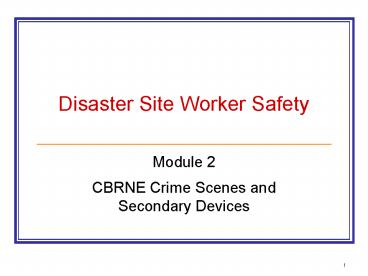Disaster Site Worker Safety - PowerPoint PPT Presentation
1 / 21
Title:
Disaster Site Worker Safety
Description:
Identify the elements of CBRNE event and indicators of their presence at ... Moving cautiously. Wearing the appropriate personal protective equipment (PPE). 10 ... – PowerPoint PPT presentation
Number of Views:68
Avg rating:3.0/5.0
Title: Disaster Site Worker Safety
1
Disaster Site Worker Safety
- Module 2
- CBRNE Crime Scenes and Secondary Devices
2
Objectives
- List the primary indicators that identify a crime
scene. - Define evidence.
- Define chain-of-custody.
- Identify the elements of CBRNE event and
indicators of their presence at a scene. - List secondary IEDs and their dangers to
personnel responding to a CBRNE event.
3
Objectives (continued)
- Explain the basic function of the Incident
Command System. - Identify the psychological stress associated with
working in a CBRNE event. - Categorize safety issues and the type of safety
equipment needed at a CBRNE site. - Describe area search methods for detecting the
presence of secondary devices targeted at
responders.
4
Crime Scene Introduction
- Successful response to a CBRNE crime scene takes
a cooperative effort by all response agencies
involved. - In order for this interagency cooperation to take
place, all agencies must have a basic
understanding of the roles and function of each
another.
5
Crime Scene Management
- The site is a crime scene until proven otherwise.
- Personnel must be careful in what they do to
preserve evidence and to ensure that evidence is
collected properly.
6
Ensuring a Safe Response
- Special demands will be placed upon you and your
activities when responding to crime scenes. - You will need to coordinate closely with other
personnel to ensure that you and the other
responders do not destroy important evidence. - The incident ends only when there is successful
prosecution of the guilty person or persons.
7
Crime Scene Security
- Protection of personnel in and around the scene
- Preservation of evidence
- Maintain integrity of the scene
- Prevent unauthorized removal of evidence and
souvenirs - Prevent entry of unauthorized personnel
8
Crime Scene Security
- Employing barriers
- Barrier tape
- Concrete barriers
- Temporary walls
- Vehicles
- Personnel
9
Scene Considerations
- Your safety and survival may depend upon entering
the area - Carefully.
- Moving cautiously.
- Wearing the appropriate personal protective
equipment (PPE).
10
Delaying Entry
- When you suspect hazardous substances, hazardous
conditions, or CBRNE agents, use only qualified
personnel to secure the scene to determine the
presence or absence of CBRNE agents. - Await the proper response personnel do not place
untrained and unprotected disaster site workers
at risk.
11
Evidence/Chain of Custody
- Evidence is anything that proves a fact at a
crime scene. - Evidence includes soil, air, human remains,
clothing, and tire and footwear impressions. - Evidence could be as small as a body fragment or
a wire from an IED.
12
Evidence/Chain of Custody
- There could be a time when a disaster site worker
may locate an item that has evidentiary value,
should this happen - Stop the activity.
- Do not pick up the item or examine it as it may
be contaminated, fragile, and may contain other
evidence such as fingerprints, hairs, fibers,
etc. - Stay with the item.
- Notify an investigator.
- Do not resume work until told to do so.
13
Documentation
- Field notes
- Reports
- Video tapings and photos of the scene
- Sketches and drawings of the scene
14
Disaster Site Worker Notes
- Date
- Time in and out of the scene
- Brief description of the days activities
- Identification of the evidence and its location
- Who took the evidence
- Where casualties/fatalities were found
15
Searches
- Outside searches
- Strip or line
- Spiral
- Grid
- Quadrant
16
Strip or Line Search
17
Spiral Search
18
Grid Search
19
Searches
- Building
20
Room Searches
- Four levels of room searches
- Floor to waist
- Waist to chin
- Chin to ceiling
- False ceiling
21
Leave Things As You Find Them
- If you must move something, make sure you
remember its original location, its orientation
and condition, and anything else notable about
its position and natural state. - If possible, photograph the object before you
move it.

